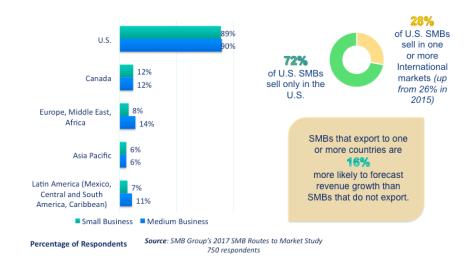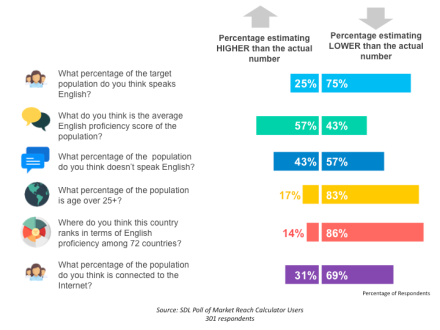Are you considering expanding your business into overseas markets? Moving beyond U.S. borders to international markets can help companies reach new customers and fuel business growth. Using digital technologies, even very small businesses can take advantage of opportunities to enter new markets, sell their products and services to new customers, and grow their top and bottom lines.
Currently, 28% of U.S. SMBs conduct business beyond U.S. borders (Figure 1), up from 26% in 2015. As they take the time to evaluate international opportunities, more SMBs are realizing that they can create a competitive trade opportunity in other countries based on product, service or price advantages. Once they get up and running overseas, their investments in international markets generally pay off: SMBs that export to one or more countries are 16% more likely to forecast revenue growth than SMBs that do not export.
Figure 1: Where U.S. SMBs Do Business?
But, determining whether your business has a viable international offering is just the first step to successfully expand into a new geographical market. In addition to putting solid legal, financial, regulatory and operational practices in place, SMBs have to create a great customer experience, personalized to the needs and preferences of the target market.
To do, this, you literally need to speak your customers’ language. Accurate, current and properly localized information—on your website, marketing assets and in product documentation—is critical to getting this right.
But sometimes, decision-makers wrongly assume that people in other countries speak English, or misjudge their English proficiency skills (Figure 2). They think customers will be satisfied with English language materials, or minimal localization. These miscalculations cam result in communication and quality issues that turn off prospects and customers.
Figure 2: Assessing English Competency and Other Demographics in International Markets: Perception Vs. Reality
To help you size up the situation more accurately, SDL, which provides managed translation services, has developed a free Market Reach Calculator. In addition to providing accurate information about English proficiency, the calculator also offers recommendations about the best ways to localize content in a particular country (Figure 3).
Figure 3: SDL Market Reach Calculator Results
In just a few minutes, the Market Reach Calculator will give you a clear snapshot of English capabilities in the countries you’re targeting. Armed with this knowledge, you can you take the most appropriate steps—whether human, advanced machine, or a combination of translation services—to localize your sales, marketing and service content to speak your customers’ language. This can help ensure that you won’t lose out on opportunities or risk customer dissatisfaction because your message is getting lost in translation.
Summary and Perspective
Today’s global, connected business environment gives SMBs more opportunities than ever before to grow through international trade. But you need a clear picture of the market opportunity, challenges and requirements in order to succeed. Tools such as SDL’s Market Reach Calculator and other resources can help you be better informed and prepared to deliver a positive customer experience and win in new markets.
This post is sponsored by SDL.
